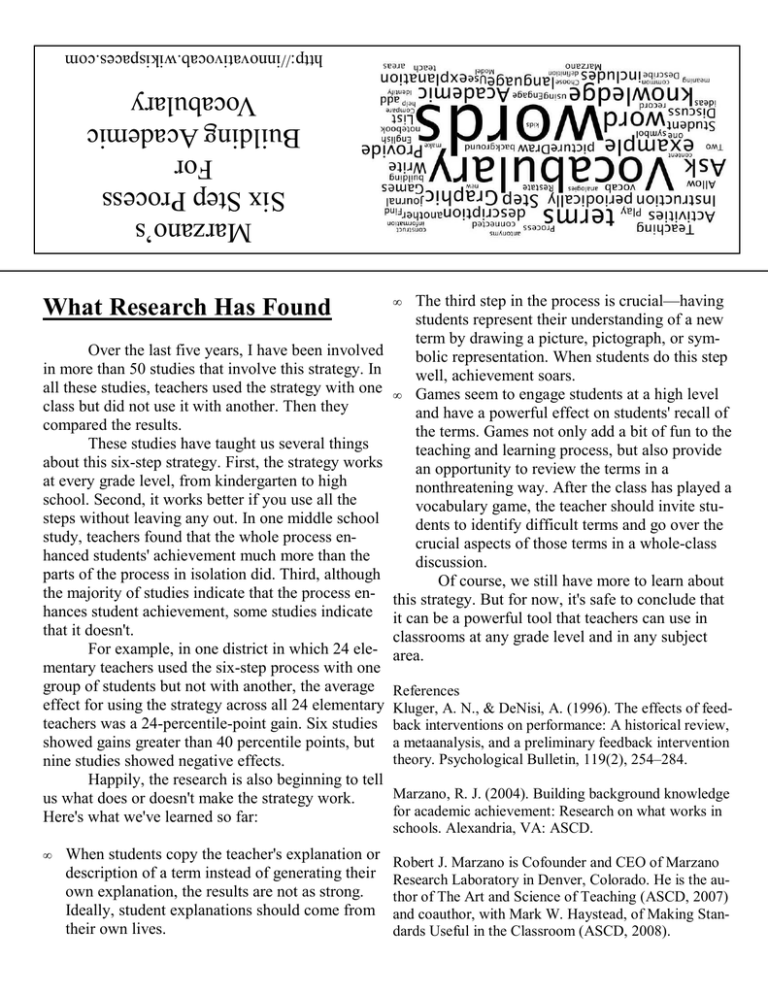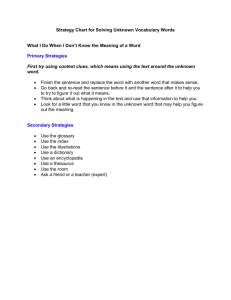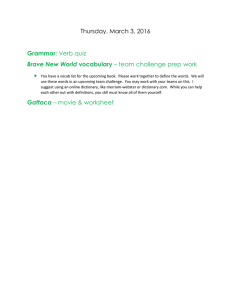Marzano`s Six Step Process For Building Academic Vocabulary
advertisement

http://innovativocab.wikispaces.com Marzano’s Six Step Process For Building Academic Vocabulary What Research Has Found Over the last five years, I have been involved in more than 50 studies that involve this strategy. In all these studies, teachers used the strategy with one class but did not use it with another. Then they compared the results. These studies have taught us several things about this six-step strategy. First, the strategy works at every grade level, from kindergarten to high school. Second, it works better if you use all the steps without leaving any out. In one middle school study, teachers found that the whole process enhanced students' achievement much more than the parts of the process in isolation did. Third, although the majority of studies indicate that the process enhances student achievement, some studies indicate that it doesn't. For example, in one district in which 24 elementary teachers used the six-step process with one group of students but not with another, the average effect for using the strategy across all 24 elementary teachers was a 24-percentile-point gain. Six studies showed gains greater than 40 percentile points, but nine studies showed negative effects. Happily, the research is also beginning to tell us what does or doesn't make the strategy work. Here's what we've learned so far: • When students copy the teacher's explanation or description of a term instead of generating their own explanation, the results are not as strong. Ideally, student explanations should come from their own lives. • The third step in the process is crucial—having students represent their understanding of a new term by drawing a picture, pictograph, or symbolic representation. When students do this step well, achievement soars. • Games seem to engage students at a high level and have a powerful effect on students' recall of the terms. Games not only add a bit of fun to the teaching and learning process, but also provide an opportunity to review the terms in a nonthreatening way. After the class has played a vocabulary game, the teacher should invite students to identify difficult terms and go over the crucial aspects of those terms in a whole-class discussion. Of course, we still have more to learn about this strategy. But for now, it's safe to conclude that it can be a powerful tool that teachers can use in classrooms at any grade level and in any subject area. References Kluger, A. N., & DeNisi, A. (1996). The effects of feedback interventions on performance: A historical review, a metaanalysis, and a preliminary feedback intervention theory. Psychological Bulletin, 119(2), 254–284. Marzano, R. J. (2004). Building background knowledge for academic achievement: Research on what works in schools. Alexandria, VA: ASCD. Robert J. Marzano is Cofounder and CEO of Marzano Research Laboratory in Denver, Colorado. He is the author of The Art and Science of Teaching (ASCD, 2007) and coauthor, with Mark W. Haystead, of Making Standards Useful in the Classroom (ASCD, 2008). 1. Provide a description, explanation, or example of the new term. • Looking up words in dictionaries is not useful for teaching vocab • Provide a context for the term • Introduce direct experiences that provide examples of the term • Tell a story that integrates the term • Use video as the stimulus for understanding information • Ask students to investigate the term and present the information to the class (skit, pantomime, poster, etc.) • Describe your own mental picture of the term • Find or create pictures that explain the term Resources: http://innovativocab.wikispaces.com Visuwords.com Visuwords is an awesome visual tool to find new words and improve your vocabulary. When you look up a word in this tool, it shows a neat graph which connects that word to various other words based on different relationships between them. You can hover over each word to get its definition and also zoom-in and zoom-out using your mouse wheel. It's certainly an excellent dictionary plus thesaurus. words in a different way. It aggregates various links on the web which provide an explanation to the term and shows the results. Hence it does the job of pulling definitions of the word from the entire web. Thsrs ( http://www.ironicsans.com/thsrs/ ) Thsrs helps you to get shorter synonyms of long words. Although it's not dead accurate but still can be useful at times. It also provides a browser plug-in to easily look up shorter synonyms of words with a right click. Wordsmith ( http://www.wordsmith.org/ ) Wordsmith is a nice resource for new words, especially its ' A Word A Day ' newsletter, which is immensely popular and Dictionary.com delivers new words everyday to your email inbox. Also inDictionary.com is probably the most common and most com- cludes the Internet Anagram Server—a really cool Anagram prehensive of all the dictionary tools available. Apart from creator! giving the word meanings and pronunciation, it also provides various tools (like the dictionary.com toolbar), RSS feeds to Thinkmap Visual Thesaurus improve vocabulary and word explorer podcasts. ( http://www.visualthesaurus.com/ ) Thinkmap Visual Thesaurus is a free-to-try visual tool which Thesaurus.com shows related words in an interactive map and helps you to Thesaurus.com is a part of dictionary.com and gives an elabo- easily find their meanings and listen to their pronunciation. rate description of words, the part of speech they belong to and various synonyms and antonyms of that word. AskOxford.com AskOxford is the online version of the famous dictionary by Merriam-Webstar Online the Oxford University press. It's comprehensive without a ( http://www.merriam-webster.com/ ) doubt and includes various other vocabulary resources and a Merriam-Webstar Online is a huge online resource for learn- quotations dictionary. ing and improving your English. It provides dictionary and thesaurus which includes spanish-english and medical diction- Alpha Dictionary aries. You can easily look up words and listen to their pronun- ( http://www.alphadictionary.com/index.shtml ) ciation. Further it provides other resources like crosswords Alpha Dictionary doesn't directly show you the meaning of a and word games. It also has a visual dictionary which comword. Instead it searches all the available online dictionaries bines words with images. (most of them) and displays the results in the form of links to the meaning of that word in those dictionaries. So choose your MetaGlossary.com favorite dictionary (if at all you have one) and click on the MetaGlossary.com approaches the task of finding meanings of corresponding link to view its meaning. 2. Ask students to restate the description, explanation, or example in their own words. • • • • Monitor and correct misunderstandings Must be student’s original ideas, not parroting the teacher Discuss with a partner Student record (notebook or journal) Learning Games-Involve students in games that allow them to play with terms. Games might be one of the most underused instructional tools in education. Many types of games can help teachers keep new terms in the forefront of students' thinking and allow students to reexamine their understanding of terms. It is important to set aside blocks of time each week to play games in order to energize students and guide them in the review and use of important terms. • • • • • • • • • • • Jeopardy Pyramid I have, who has? Pictionary Memory Jeopardy (vocab words are on the board, players make up a question to define) Charades Name that Category ($100,000 Pyramid) Bingo (you give definition, kid marks the word) Create a skit (assign groups of 3-4 kids 3 vocab words to make a skit out of) Kids Make their own game / Gamigami Notes: ____________________________________ ____________________________________ ____________________________________ ____________________________________ ____________________________________ ____________________________________ ____________________________________ ____________________________________ ____________________________________ ____________________________________ ____________________________________ ____________________________________ ____________________________________ 6. GAMES BEFORE you begin your next UNIT of INSTRUCTION: 1. What Power Indicators (standards) are included in this Unit? List indicators. 2. What is the key academic vocabulary needed in this Unit? List words. Plan for direct vocab. instruction: (Marzano’s 6 Steps for Teaching Vocab.) 1. YOU provide a description, explanation or example. (story, sketch, powerpoint) 2. Ask students to re-state or re-explain meaning in their own words. (journal, community circle, turn to your neighbor) 3. Ask students to construct a picture, graphic, or symbol for each word. 4. Engage students in activities to expand their word knowledge. (add to their notes, use graphic organizer format) 5. Ask students to discuss vocabulary words with one another. (collaborate) 6. Have student play games with the words. (Bingo w/definitions, Pictionary Charades, etc.) 3. Plan to provide or activate background knowledge: __ Study Trip __ __ Bring In Live Sample __ __ Theme Day (“Indian Day”) __ __ Show Photos __ __ Posters __ __ Graphic Organizer __ __ Community Circle Topic __ Guest Speaker (expert) Bring In Actual Artifacts Video (United Streaming) Read Aloud (story) Models of Actual Items PowerPoint / Other Technology Other _______________________________________________________________________________ _______________________________________________________________________________ _______________________________________________________________________________ _______________________________________________________________________________ First, a teacher should provide students with information about the new term. Teachers can... NOTES: _______________________________________________ • • • tell a story using the term. _______________________________________________ use video or computer images as a source of information. _______________________________________________ use current events to connect the term to something familiar. • describe their own mental pictures of the term. _______________________________________________ • find or create pictures that exemplify the term. _______________________________________________ Notice that some of these suggestions include providing images. Using both linguistic and nonlinguistic explanations _______________________________________________ of a new term will help students develop an initial _______________________________________________ understanding of the term, as well as help prepare them to create their own pictures or graphic representations in Step 3 of the process. _______________________________________________ 1. DESCRIPTION 3.Ask students to construct a picture, symbol, or graphic representing the word. • • • • • • • • Model, model, model Provide examples of student’s drawings (and your own) that are rough but represent the ideas Play “Pictionary” Draw an example of the term Dramatize the term using speech bubbles Let them find a picture on the internet, if necessary Create Comic Books Use Web 2.0 Tools from http://innovativocab.wikispaces.com Refine and reflect-Ask students to return to their previous work to discuss and refine entries. NOTES: ______________________________________ Both research and common sense suggest that in- ______________________________________ teracting with other people about what we are learning deepens the understanding of everyone ______________________________________ involved-particularly when we are learning new terms. ______________________________________ During Step 5, students examine their vocabulary ______________________________________ to make changes, deletions, and additions. The teacher might ask students to do this in pairs or ______________________________________ small groups. Students might: ______________________________________ • compare their descriptions of the term. • describe their pictures to each other. ______________________________________ • explain to each other any new information they have learned or new thoughts they have ______________________________________ had since the last time they reviewed the terms. ______________________________________ • identify areas of disagreement or confusion and seek clarification. ______________________________________ 5. STUDENT DISCUSSION 6. Involve students periodically in games that allow them to play with terms. • • • • • • Games are used to help and encourage many learners to sustain their interest and work and help the teacher to create context in which the vocabulary is useful and meaningful. The learners are requested to take part and in order to do so, they must understand what others are saying or have written, and they must speak or write in order to express their own point of view or give information. So, by this way, they are not only improving their vocabulary, but they are also improving their communication skills. Listen for misconceptions when learners are playing games/activities. Provides an opportunity for learners to work together. Gives in-context and out-of-context opportunities to apply, analyze, evaluate and synthesize new vocabulary. Restate-Ask students to restate the description, explanation, or example in their own words. During the second step, the teacher asks students to restate the meaning of the term in their own words. It is critical that instead of simply copying what the teacher has said, the students "own" the new terms by constructing their own descriptions, explanations, or examples. Their constructions need not be comprehensive, but efforts should be made to ensure they do not contain major errors. It is useful to have students record their descriptions, explanations, and examples in a vocabulary notebook. For each term, the notebooks should provide a space for students' descriptions (Step 2), students' picture or representation of the term (Step 3), and room for additional information students might add as a result of Steps 4, 5, and 6. NOTES: _____________________________________________ _____________________________________________ _____________________________________________ _____________________________________________ _____________________________________________ _____________________________________________ _____________________________________________ _____________________________________________ 2. RESTATE 4. Engage students periodically in activities that help them add to their knowledge of the terms in their notebooks. • • • • • • • • • • Highlight prefixes, suffixes, root words that will help them remember the meaning of the term Identify synonyms and antonyms for the term List related words Write brief cautions or reminders of common confusions Translate the term into another language for second language students Point out cognates to words in Spanish Write incomplete analogies for students to complete Allow students to write (or draw) their own analogies Sort or classify words Compare similarities and differences Discuss-Engage students in discussion activities that help them add to their knowledge of the terms in their vocabulary notebooks. During the fourth step, students are engaged in activities designed to help them discuss and review the new terms. These activities include having students compare and contrast terms, classify terms, identify antonyms and synonyms, and create analogies and metaphors using the terms. During this time, students should be provided with opportunities to add to or revise the entries in their vocabulary notebooks if they are using them or wherever they are recording information about their new vocabulary. NOTES: ________________________________ ________________________________ ________________________________ ________________________________ ________________________________ ________________________________ ________________________________ ________________________________ ________________________________ 4. ACTIVITIES 5. Periodically ask students to discuss the terms with one another. • • • • • • Think-Pair-Share Compare their descriptions of the term Describe their pictures to one another Explain to each other any new information they have learned (“aha’s”) Identify areas of disagreement or confusion and seek clarification Students can make revisions to their own work Step 3: Show-Ask students to construct a pic- NOTES: ture, symbol, or graphic representation of the ________________________________________ term. In Step 3, students are asked to construct a picture, symbol, or graphic representation of a term; this forces them to think of the term in a totally different way. Written or oral descriptions require students to process information in linguistic ways. Pictures, symbols, and graphic representations require students to process information in nonlinguistic ways. ________________________________________ ________________________________________ ________________________________________ ________________________________________ ________________________________________ If students are not accustomed to creating pictures ________________________________________ and graphics for ideas, they might initially need significant guidance and modeling. Even if they have experience with nonlinguistic representations, ________________________________________ it is likely that they will still need help with terms ________________________________________ that are difficult, new to them, or abstract. 3. NONLINGUISTIC REPRESENTATION





